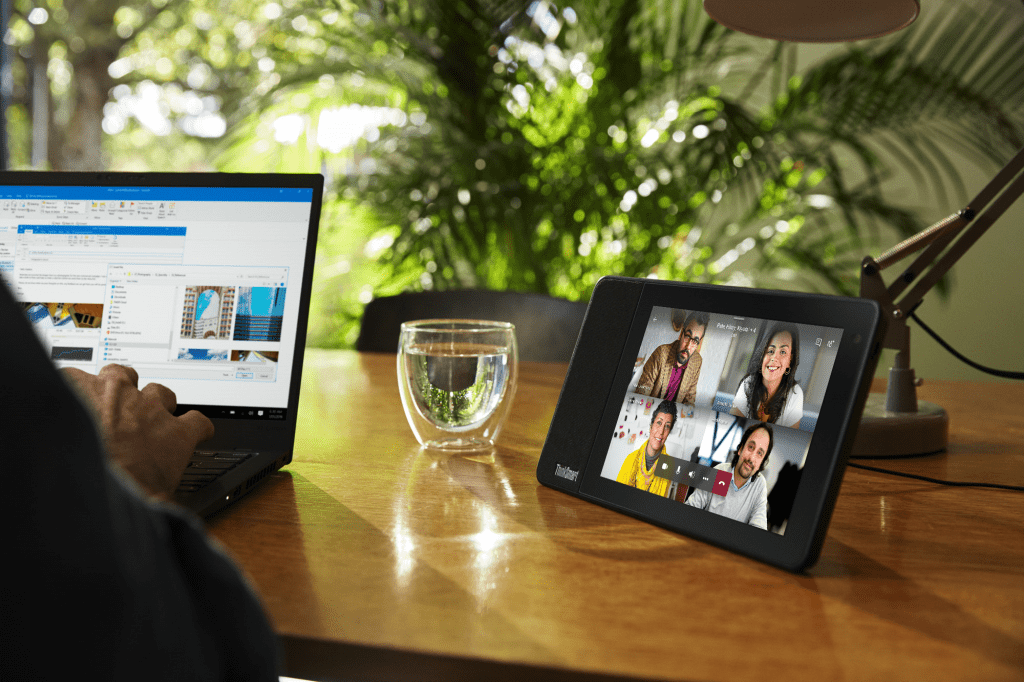Research Triangle, NC, March 22, 2021 – One year after the global remote work revolution, the shift to work from home (WFH) and work from anywhere (WFA) is already resulting in profound effects on businesses’ digital transformation as well as data security concerns. According to Lenovo’s new Future of Work and Digital Transformation study, a vast majority of businesses (83 percent) expect to work remote at least half the time, whereas 60 percent of employees not only agree but are happy to do so. These new findings are part of a global survey of more than 8,000 employees and IT decision-makers (ITDMs) across 14 markets from companies of all sizes on the impact of remote work, including job satisfaction, technology challenges and solutions conducted in early 2021.
Among the key insights is that workers have hit their stride navigating their new WFH lives. Most employees (83 percent) want a hybrid work model post-COVID, which businesses say are more than happy to accommodate because they know it’s a way to drive employee engagement and attract new talent. Enabling remote work has meant a change in digital adoption, with an increased usage of personal devices for work; wider adoption of collaboration cloud and software; and a heightened focus on data security among IT functions across businesses of all sizes. The study also shows that trusted technology providers will need to play a key role in developing future digital strategies, while Device-as-a-Service (DaaS) is gaining traction among larger businesses to make it easier to provide employees with up-to-date technology devices and as a way to free up precious resources for more strategic priorities.
“With businesses and their employees both optimistic about a future in hybrid work and remote collaboration, today’s IT departments are faced with the rising resource costs of data security and compliance,” said Gianfranco Lanci, President and Chief Operating Officer, Lenovo. “More than ever, businesses need reliable technology partners to fully manage their hardware, software and services to maximize value and boost security.”
Employees overcome remote work burnout and start embracing hybrid work
Contrary to initial concerns that remote work would lead to a rise in employee burnout within the first year of the pandemic, the Lenovo study showed that most workers have adapted remarkably well to WFH and WFA – 70 percent say that the flexibility leaves them more satisfied with their job overall. About 60 percent of surveyed employees now prefer remote work at least half the time, while over one-third want to WFH/WFA most or all of the time. This sentiment increases among workers in larger companies, with approximately two-thirds of those respondents in large companies preferring to work remote at least half the time. It’s not unusual, particularly in large organizations, to be working with teams across continents and time zones, which make the physical location of an office less relevant for effective collaboration.
Employees nevertheless cite a number of challenges. Chief among them are slow or unstable Internet connections at home. Additionally, about half the employees in medium-sized businesses (50 percent) and small or very small businesses (42 percent) report delays or challenges in getting any kind of IT support when needed. Businesses may want to consider always-connected PCs with integrated LTE or 5G as a way to offer employees freedom from reliance on the home Wi-Fi network alone and to provide higher security. Smarter devices, services and software solutions that can self-diagnose and pre-empt IT issues can also help small businesses that don’t typically have a robust IT support team.
With 90 percent of workers surveyed still wanting the option to go into the office to connect with colleagues and 56 percent saying they are more productive at home, it’s clear that the role of the office will be changing. The office is no longer the place where work gets done; it’s evolving into a place where one can connect and collaborate while leaving deep work for focused time at home.


The blurring lines of workers’ personal and professional digital devices show how we work
Remote work has also led to a new suite of digital hardware, software and services solutions. One’s collection of devices and technology for work has become increasingly personal and collaborative. Employees are increasingly leaning into the use of their personal devices such as laptops, smartphones and tablets for work, with 79 percent of employee respondents saying they’re now using their smartphones for work-related tasks such as voice and video calls, email and work chat. When it comes to PCs, technologies such as AI-based noise cancellation during calls, webcam privacy shutter for when the camera’s not in use, eye care for displays’ natural low blue light and better device cooling all rank as the top smart device features across employees of all business sizes. However, workers aren’t taking enough advantage of company programs to finance their technology purchases. While 80 percent of IT departments reported they are willing to cover purchases of work-related equipment, sometimes as little as 22 percent of employees have used these policies.
Unsurprisingly, collaboration cloud and software tools for needs like videocalls and simultaneous document collaboration are now essential for a whopping 97 percent of employees. Almost two-thirds of respondents also say that these tools help improve productivity and efficiency.


Innovation first, security always – There’s no digital transformation without digital security and services
With the increasing use of remotely-connected cloud and collaboration tools – where even smart home devices may increase risk to company data as employees log on from home – data security has understandably jumped to the forefront of IT considerations and is now the number one priority for digital transformation. This concern is putting a growing strain on IT department resources. ITDMs feel more prepared for another pandemic than against data threats. Data security and compliance are now siphoning the most time and money from IT functions, while most large and medium-sized companies already subscribe to an IT security service.
Businesses of all sizes will need to grapple with how best to keep themselves secured with the integration of partner security services, and commit to a more agile business-centric approach to security that also focuses on the cloud and data. Against these growing concerns, almost all businesses report having some sort of continuity plan in place, such as cloud-based data backup (45 percent), physical data backup (39 percent) and data security training (39 percent).



With the rise of the subscription culture, ITDM respondents – particularly from medium and large businesses – also expressed growing interest in DaaS solutions which can keep hardware up to date, scale technology needs over time, and even free up time and resources for more strategic projects. With a tenth of businesses currently subscribing to a DaaS-like service, almost two-thirds (63 percent) are showing more interest – pointing to an increased crossover of the ‘everything-as-a-service’ (EaaS) trend from the consumer into the commercial realm. Expect the EaaS model to also expand and expedite IT deployments into turnkey solutions – shortening timeframes from months to days.
Access the full study directly and download the image set in the press kit.
About Lenovo’s Future of Work and Transformation Study
Fieldwork for this study was conducted via a quantitative survey from January 15 to February 11, 2021, on a total of 8,533 global respondents. The survey sample comprised of a near equal number of respondents from each market: Australia, Brazil, China, France, Germany, India, Indonesia, Italy Japan, Mexico, Russia, Singapore, the United Kingdom and the United States. Respondents included business end-users currently working from home who worked in the office prior to the pandemic and IT decision-makers whose companies have made policy or work location changes due to the pandemic from March 2020 onwards.
About Lenovo
Lenovo (HKSE: 992) (ADR: LNVGY) is a US$50 billion Fortune Global 500 company, with 63,000 employees and operating in 180 markets around the world. Focused on a bold vision to deliver smarter technology for all, we are developing world-changing technologies that create a more inclusive, trustworthy and sustainable digital society. By designing, engineering and building the world’s most complete portfolio of smart devices and infrastructure, we are also leading an Intelligent Transformation – to create better experiences and opportunities for millions of customers around the world. To find out more visit https://www.lenovo.com, follow us on LinkedIn, Facebook, Twitter, YouTube, Instagram, Weibo and read about the latest news via our StoryHub.

